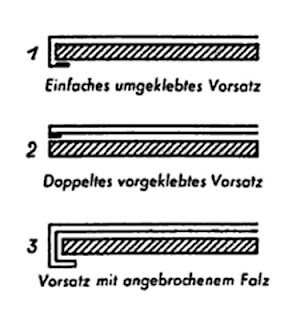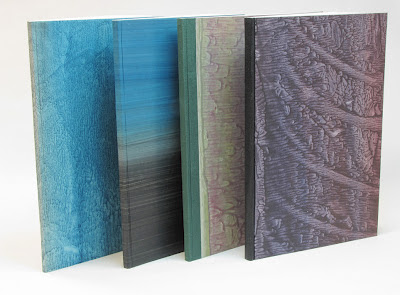Sunday, September 30, 2012
Sunday, September 9, 2012
Working in the Studio
Spent a lot of good quality time this weekend working in the studio on some private work and bindings for myself. Felt really good for the hands and soul. Below pictures of my space, one that I always dreamed of, and was finally able to realize when we moved into this house 9 or so years ago... May well be doing quite a bit more work there in the future...
Tuesday, June 26, 2012
German Stiffened Paper Bindings - 2
That there was once the idea that books were functional items, not fetishized objects that should take as long as possible to make and should include many unnecessary features.
That "good enough" is sometimes an appropriate, and even a noble goal, not an abomination.
Karen Hanmer (4/26/2012)
Known as broschuren and steifbroschuren in German, these brochures, pamphlets, and other related bindings have long been a part of the German bookbinding tradition. These can range from single section pamphlets with simple wrappers to adhesive bound or sewn textblocks in wrappers, to hard cover variants. In all cases the common thread is providing the texts with a simple yet functional binding that may or may not be intended to be permanent.
In my previous post I provided some images of historical examples of this structure from Syracuse University Library's von Ranke collection. In this post I will provide a more tutorial-like description (a more formal article is in preparation) of some of the variations that are common.
The textblock I have used is my translation of Collin's Der Pressbengel available as The Bone Folder in a pdf version laid out in signatures. See the link in the left side bar to download. As was, and remains, common to most books, the letter-sized paper I used has the grain running perpendicular to the spine resulting in some cockling of the textblock due to moisture from the adhesive used to attach the boards and covering... There, got that out of the way.
Forwarding of these is very minimal, endsheets generally a single sheet or folio that is folded/hooked around the first and last signature or a simply a tipped on folio.
Historically, sewing was generally a simple unsupported stitch (Holländern). Several books would be sewn together in stacks and then separated into the individual volumes by cutting the threads between after the pasting/gluing up of the spines. Staples were also common in lieu of sewing with thread. After being separated, the spines were repasted/glued and inserted into a folded paper wrapper. In some cases the wrapper was also pasted to the endsheet to make a slightly stiffer cover.
 |
| Detail from Stitches and Sewings for Bookbinding Structures by Betsy Palmer Eldridge. Presented at the Guild of Book Workers Standards of Excellence, October 2008 |
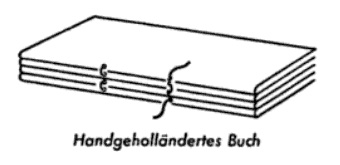 |
| Detail from Wiese's Der Bucheinband. |
In the variant with stiff boards, endpapers were identical, with a single tipped on folio also being used, especially in the 20th century. Sewing was often more robust using a linked stitch, but also tapes, slips, or recessed cords being used. After sewing, the spine was pasted/glued as before. The book could also be rounded but was not backed to save a step.
Next thin boards were cut to the height of the textblock, with a width that allowed for a narrow “groove” and for edge square. The top/bottom endsheets are pasted/glued out, the boards positioned and the book given a quick nip in the press. The book would then be covered with full paper, cloth on spine and paper on boards, or full cloth. Cloth would generally be thinner, and was not turned in, except occasionally at fore edge. Next, all three edges were trimmed flush unless a fore-edge square was left, in which case only top and bottom were trimmed. Finally a label could be applied.
Steps that follow will describe several variants that can be applied to sewn and adhesive bound structures using soft and stiff boards (Steifbroschuren).
Adhesive bound:
I use this style to bind text printed out from Google Books, books that arrived with spiral-type bindings, or simple substantial photocopied articles... Not beautiful but very functional.
Cut single folio endsheets to fit textblock. Precut thin cloth/muslin to height of textblock and ca 6cm wider than spine. Put endsheets on both sides of textblock and double-fan adhesive bind applying thin cloth centered on spine ensuring that it is well adhered with glue seeping through. Put in press with boards just shy of spine edge and close press tightly.
When dry, cut boards proportionate in thickness to the size of the book to the height and width of the textblock. To attach boards apply adhesive first to the outer sheet, put down cloth hinge, apply adhesive over cloth (all as if casing in) and then put down first board, setting it back from the spine by about 5 millimeters. Repeat with other side. Insert fences of thin cardstock between pastedowns and text, and put in press giving it a good hard nip.
To cover, cut cloth to cover spine and reaching onto board (or fully cover spine and both boards). Work cloth into groove ensuring good adhesion to spine, then onto remaining board. Using edged casing-in boards give quick nip, take out. If only spine was covered, leave remaining board bare or cover with a contrasting paper or cloth.
If a fore-edge square is left, trim this to the desired size before covering, cover, trim so that it is no more than a centimeter, and then turn-in.Put between boards and under weight to dry.
Trim 3 sides so as to be flush, i.e. no squares. If a fore-edge square was left, trim only at head and tail.
Apply label to spine of front board as/if desired.
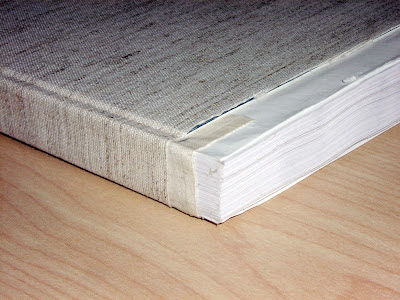 |
| Adhesive bound before trimming showing layers. |
 |
| Adhesive bound after trimming |
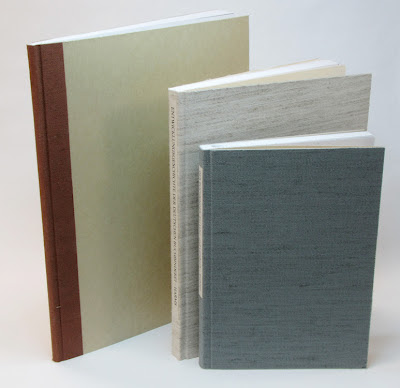 |
| A selection of adhesive bound volumes. At left only spine covered with bare boards. |
Simple unsupported stitch (geholländert):
Sewn using the very basic unsupported stitch described above is historical and not something I would apply to a binding that will be used. An unsupported linked stitch will work much better.
Sew textblock using an unsupported linked stitch with a single-folio endsheet hooked around the first and last signatures. This will become the pastedown. After sewing square up and glue up spine.
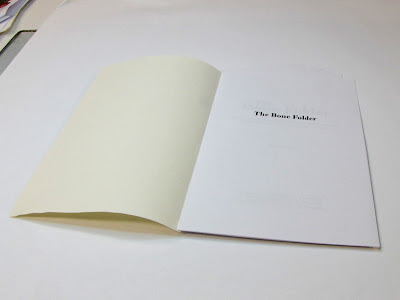 |
| Single leave hooked around first signature prior to sewing. |
 |
| Sewing completed, but not yet glued up. Image shows how signatures are only connected with each other at one point with two stations total. See earlier diagrams above for more detail. |
When dry, cut thin boards proportionate in thickness to the size of the book to the height and width of the textblock. To attach boards apply adhesive first to the outer sheet and then put down first board, setting it back from the spine by about 5 millimeters. Repeat with other side. Insert fences of thin cardstock between pastedowns and text, and put in press giving it a good hard nip.
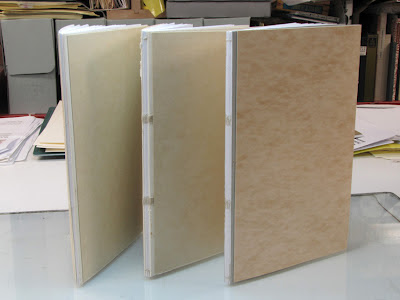 |
| Boards attached after sewing From left: Simple unsupported; sewn on tapes; unsupported link stitch. |
To cover, cut paper or cloth to cover spine and reaching onto board (or fully cover spine and both boards). Work material into groove ensuring good adhesion to spine (there should be no "hollow"). If only spine was covered, leave remaining board bare or cover with a contrasting paper or cloth.
If a fore-edge square is left, trim this to the desired size before covering, cover, trim so that it is no more than a centimeter, and then turn-in. Put between boards and under weight to dry.
Trim 3 sides so as to be flush, i.e. no squares. If a fore-edge square was left, trim only at head and tail.
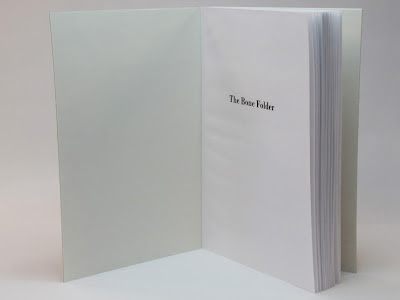 |
| Interior view after trimming. |
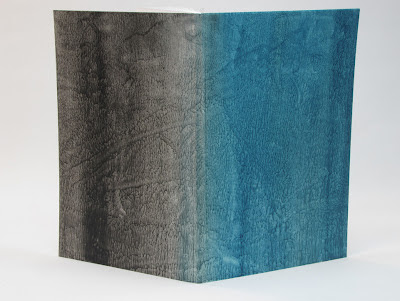 |
| Exterior view after trimming. |
Apply label to spine of front board as/if desired.
Folio endsheet hooked around first and last signatures and sewn on tapes:
Sew textblock on tapes with using a double-folio endsheet section that is hooked around the first and last signatures. After sewing glue up spine.
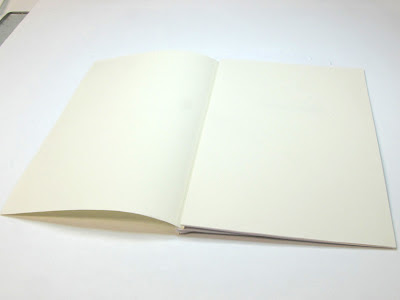 |
| Single folio hooked around first signature prior to sewing. |
When dry, cut thin boards proportionate in thickness to the size of the book to the height and width of the textblock. To attach boards apply adhesive first to the outer sheet and then put down first board, setting it back from the spine by about 5 millimeters. Repeat with other side. Insert fences of thin cardstock between pastedowns and text, and put in press giving it a good hard nip. [See earlier image above]
To cover, cut paper or cloth to cover spine and reaching onto board (or fully cover spine and both boards). Work material into groove ensuring good adhesion to spine (there should be no "hollow"). If only spine was covered, leave remaining board bare or cover with a contrasting paper or cloth.
If a fore-edge square is left, trim this to the desired size before covering, cover, trim so that it is no more than a centimeter, and then turn-in. Put between boards and under weight to dry.
Trim 3 sides so as to be flush, i.e. no squares. If a fore-edge square was left, trim only at head and tail.
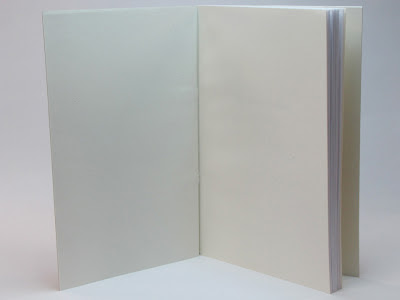 |
| Interior view after trimming. Note tapes under pastedown. |
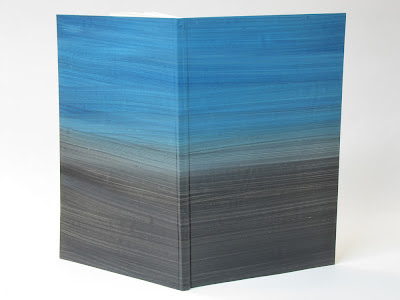 |
| Exterior view after trimming. |
Apply label to spine of front board as/if desired.
Spine covered separately with fore-edge squares:
For these these last two books, I used a single folio endsheet tipped-onto the first and last signatures. Sewing was with an unsupported linked stitch. After sewing the textblock was glued up.
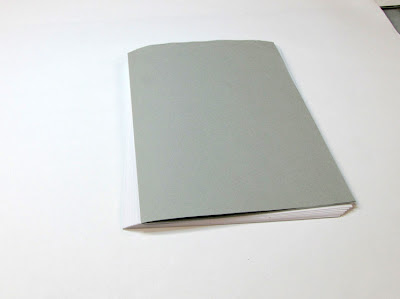 |
| Single folio tipped-on endsheet. |
When dry, cut thin boards proportionate in thickness to the size of the book to the height and width of the textblock. To attach boards apply adhesive first to the outer sheet and then put down first board, setting it back from the spine by about 5 millimeters. Repeat with other side. Insert fences of thin cardstock between pastedowns and text, and put in press giving it a good hard nip. [See earlier image above]
Trim at head and tail only and trim fore-edge square to desired size.
Images below show variant in which the spine with spine stiffener was applied first leaving a hollow. In addition the spine was lined with muslin to offer more support.
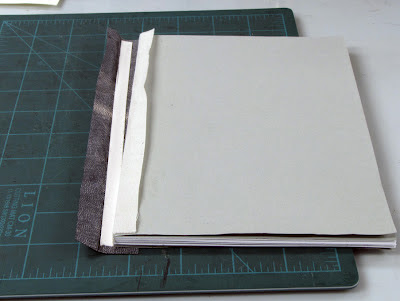 |
| Spine lined and (leather) covered stiffener ready. |
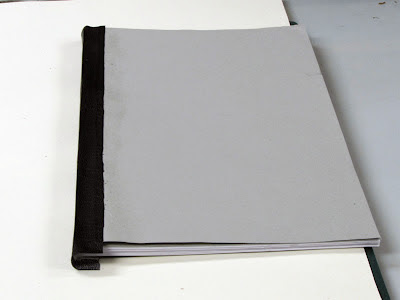 |
| Spine-stiffener attached to endsheets. |
To cover, cut paper or cloth to cover spine and reaching onto board (or fully cover spine and both boards). Work material into groove ensuring good adhesion to spine (there should be no "hollow"). If only spine was covered, leave remaining board bare or cover with a contrasting paper or cloth.
 |
| Spine covered in cloth with paper sides. Fore-edge square left with paper turned-in around. |
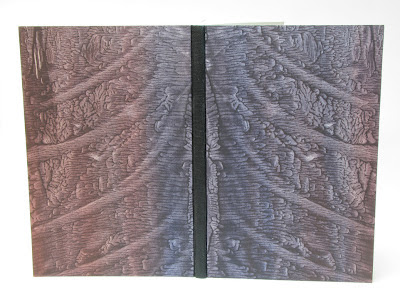 |
| Spine covered with leather before applying boards. Boards covered with paper turned in at spine edge, fore-edge square left with paper turned-in around. |
If a fore-edge square is left, trim this to the desired size before covering, cover, trim so that it is no more than a centimeter, and then turn-in. Put between boards and under weight to dry.
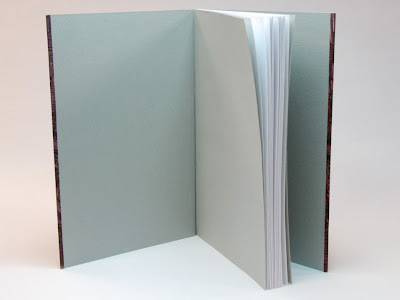 |
| Interior view showing turn-in at fore-edge. |
Trim 3 sides so as to be flush, i.e. no squares. If a fore-edge square was left, trim only at head and tail.
Apply label to spine of front board as/if desired.
The finished books:
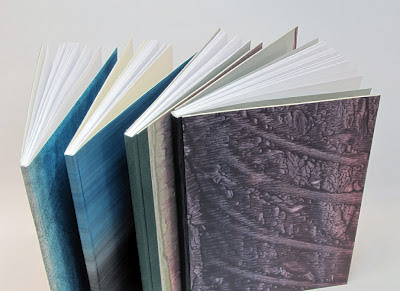 | |
| Note thickness of the boards. Two on the left use 20pt folder stock. Two on right 25pt pressboard which is stiffer than the folder stock. |
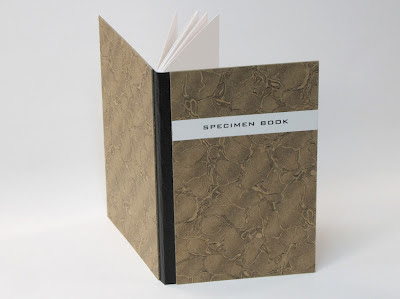 |
| Specimen Book by Barbara Tetenbaum uses this structure. |
Notes:
While the images above show 4 distinct models, this structure is very modular and can be elements can be easily moved around. It can also be used for single signature items.
Have fun and experiment.
Related resources:
Books: All titles in German but most with good diagrams...
- Adam, Paul. Title: Die praktischen Arbeiten des Buchbinders. Wien: A. Hartleben's Verlag, 1898.
- Published in English as Practical Bookbinding, London: Scott, Greenwood & Co., 1903.
- Henningsen, Thorwald. Handbuch für den Buchbinder. St. Gallen: Rudolf Hostettler Verlag, 1969.
- L. Brades illustriertes Buchbinderbuch: Ein Lehr- und Handbuch der gesamten Buchbinderei und aller in dieses Fach eingeschlagenden Techniken. Halle: Verlag von Wilhelm Knapp, 1921.
- Lüers, Heinrich. Das Fachwissen des Buchbinder. Stuttgart: Max Hettler Verlag 1943.
- Moessner, Gustav. Die täglichen Buchbinderarbeiten: Eine Unterweisung in den einfachen Arbeiten der Buchbinderei. Stuttgart: Max Hettler Verlag, 1969.
- Rhein, Adolf. Das Buchbinderbuch. Halle (Saale): VEB Wilhelm Knapp Verlag, 1953.
- Wiese, Fritz. Der Bucheinband: Eine Arbeitskunde mit Werkszeichnungen. Hannover: Schlüterische Verlagsanstalt und Druckerei, 1983.
- Zahn, Gerhard. Grundwissen für Buchbinder: Schwerpunkt Einzelfertigung.Itzehoe: Verlage Beruf + Schule, 1990.
Examples of these and other variants. In German, but with lots of diagrams.
German Stiffened Paper Bindings - 1
Henry Hébert describes the history and construction of these very basic and utilitarian bindings in his Works of the Hand blog post on November 27, 2011. Syracuse University Library's von Ranke Collection has numerous examples of the style, so I thought it would be nice to provide depictions of examples.
"Leopold von Ranke (1795-1886), a German historian and historiographer, was highly influential in shaping the modern approach to history, emphasizing such things as reliance on primary sources, narrative history and international politics. Ranke's personal and professional library, consisting of more than 10,000 books, several hundred manuscripts and approximately 5 linear ft. of personal papers, was purchased for Syracuse University in 1887 and formed the nucleus of what is now the Syracuse University Special Collections Research Center (SCRC)." (cite)
What makes this collection interesting is that it while a good bit of conservation work has been completed on works in the collection, the collection functions as time capsule for a great deal of 18th and 19th century German trade binding styles. Many of these reveal themselves as a result of the heavy use which the collection experienced when it served as the newly formed university's circulating library, making it a great (and sobering) pleasure to browse the stacks.
Known as broschuren and steifbroschuren in German, these brochures, pamphlets, and other related bindings have long been a part of the German bookbinding tradition. These can range from single section pamphlets with simple wrappers to adhesive bound or sewn textblocks in wrappers, to hard cover variants. In all cases the common thread is providing the texts with a simple yet functional binding that may or may not be intended to be permanent.
In the literature they first appear in the 3rd quarter of the 19th century, but are not given more than cursory attention. "We are all familiar with these kinds of bindings regardless of “national tradition,” in most cases do not even notice them. Perhaps that is because even if they largely saw use holding together notebooks, schoolbooks, or as “interim/provisional” bindings for other texts..." (L. Brade’s Illustriertes Buchbinderbuch. Halle: Wilhelm Knapp, 1882. Pg 195-201). Adam (Die Praktischen Arbeiten des Buchbinders, Vienna: A Hartleben’s Verlag, 1898. Pg 27) writes that “brochures are not a form of book, but nothing more than folios gathered together in a handy and useable form, in order to be more saleable. In order to prevent the individual folios from falling out if they are cut open, these are simply sewn together” [Note, links to German manuals above may not reflect the edition being quoted but freely available via Google Books. Year and pages reflect actual examples in my collection.]
The boards could be thinner (thin card stock) or more substantial (1 to 1.5mm), the covering material could be paper or cloth and was attached directly to the spine, and the book was trimmed flush either on all three sides, or just top and bottom with fore-edge square and the covering material turned in along that edge.
Below is a selection of images showing these functional bindings. Click on them for a larger view.
All binding images:Credit: Leopold v. Ranke Collection, Special
Collections Research Center, Syracuse University Libraries.
My next post will describe and depict the modern version of this structure, one that is equally suited to quickly binding photocopies, fine press editions, and most anything that is in between. Click here to read...
"Leopold von Ranke (1795-1886), a German historian and historiographer, was highly influential in shaping the modern approach to history, emphasizing such things as reliance on primary sources, narrative history and international politics. Ranke's personal and professional library, consisting of more than 10,000 books, several hundred manuscripts and approximately 5 linear ft. of personal papers, was purchased for Syracuse University in 1887 and formed the nucleus of what is now the Syracuse University Special Collections Research Center (SCRC)." (cite)
 |
| The von Ranke Library in 1910. Image from Wikimedia Commons. |
What makes this collection interesting is that it while a good bit of conservation work has been completed on works in the collection, the collection functions as time capsule for a great deal of 18th and 19th century German trade binding styles. Many of these reveal themselves as a result of the heavy use which the collection experienced when it served as the newly formed university's circulating library, making it a great (and sobering) pleasure to browse the stacks.
Known as broschuren and steifbroschuren in German, these brochures, pamphlets, and other related bindings have long been a part of the German bookbinding tradition. These can range from single section pamphlets with simple wrappers to adhesive bound or sewn textblocks in wrappers, to hard cover variants. In all cases the common thread is providing the texts with a simple yet functional binding that may or may not be intended to be permanent.
In the literature they first appear in the 3rd quarter of the 19th century, but are not given more than cursory attention. "We are all familiar with these kinds of bindings regardless of “national tradition,” in most cases do not even notice them. Perhaps that is because even if they largely saw use holding together notebooks, schoolbooks, or as “interim/provisional” bindings for other texts..." (L. Brade’s Illustriertes Buchbinderbuch. Halle: Wilhelm Knapp, 1882. Pg 195-201). Adam (Die Praktischen Arbeiten des Buchbinders, Vienna: A Hartleben’s Verlag, 1898. Pg 27) writes that “brochures are not a form of book, but nothing more than folios gathered together in a handy and useable form, in order to be more saleable. In order to prevent the individual folios from falling out if they are cut open, these are simply sewn together” [Note, links to German manuals above may not reflect the edition being quoted but freely available via Google Books. Year and pages reflect actual examples in my collection.]
The boards could be thinner (thin card stock) or more substantial (1 to 1.5mm), the covering material could be paper or cloth and was attached directly to the spine, and the book was trimmed flush either on all three sides, or just top and bottom with fore-edge square and the covering material turned in along that edge.
Below is a selection of images showing these functional bindings. Click on them for a larger view.
 |
| Simple multi-section journal articles with cloth spines, marbled sides, and fore-edge squares with turn-ins. Click on image for large image showing the embossed cloth used. |
 |
| Interior view showing fore-edge squares with turn-ins and the single-folio tipped-on endpaper (flyleaf missing). |
 |
| Cloth spine with bare boards with front of original paper wrapper adhered to front.. |
 |
| Simple stiffened paper wrapper, trimmed on all three sides with gilt edge applied after trimming. |
 |
| Interior view showing single sheet pastedown hooked around first text signature. |
 |
| Sewn on 2 recessed cords with gently rounded spine. |
 |
| Sewn on 2 vellum slips |
 |
| Sewn on 2 vellum slips |
My next post will describe and depict the modern version of this structure, one that is equally suited to quickly binding photocopies, fine press editions, and most anything that is in between. Click here to read...
Friday, April 20, 2012
Jahrbuch der Einbandkunst
The Jahrbuch der Einbandkunst (Yearbook of the Art of Bookbinding) was a journal published 4 times, 1927, 1928, 1929/30, 1937. It was published by the Meister der Einbandkunst (MDE), the German association of masters of the
art of binding that grew of out the Jakob-Krause-Bund. Both organizations included some of the most influential German binders
of the late 19th and early 20th century, among them Paul Adam, Otto Dorfner,
Paul Kersten, Franz Weiße, and Ignatz Wiemeler.
Published in German, each volume was divided into two parts, with essays by leading scholars in the field on historic and contemporary bookbinding, respectively. Included in the contemporary sections were "reviews" of the state of fine binding in individual nations allowing the reader to compare trends in design and see who was coming up in the field. The date range of 1927 - 1937 is also very interesting in particular when viewing the German contributions as this period covers the Depression, Weimar Republic, the period of the Bauhaus, and the ascendency of the Nazis. All these influenced binding design and content, often quite graphically - art, craft, and politics are very intertwined.
The copy above, bound by/in the firm of E.A. Enders (Leipzig) is from my collection. I remember being blown away by it on many levels when it was brought into Bill Minter's shop by a dealer who wanted to have a nice clamshell box made for it. Much to Bill's chagrin, the book was sold on the spot (for what was then a lot of money to me). I made a box shortly thereafter in my own, then modest dining room "studio." I very quickly found myself sucked into the essays, especially the ones on contemporary binding. It was my first (and really only) design binding purchase, and I still love to study the design, the combination of decor, the typographic elements - Germans integrated the title into designs more so than other traditions - and also the little flaws that make it "human." For instance, the titles on the spine and boards were tooled not from cast type/letters, but pieced together from various straight line pallets and curved gouges like those below.
Over time I was able to acquire the remaining 3 volumes, all in different bindings - plain 1/4 leather, rough cloth, and the paper wrapper in which it was issued. Together they provide a tremendous snapshot of the work being produced in Germany and around the world during a tumultuous period.
Other bindings on this journal can be viewed online below. Image quality not great, but they show a wide range of binding styles.
Published in German, each volume was divided into two parts, with essays by leading scholars in the field on historic and contemporary bookbinding, respectively. Included in the contemporary sections were "reviews" of the state of fine binding in individual nations allowing the reader to compare trends in design and see who was coming up in the field. The date range of 1927 - 1937 is also very interesting in particular when viewing the German contributions as this period covers the Depression, Weimar Republic, the period of the Bauhaus, and the ascendency of the Nazis. All these influenced binding design and content, often quite graphically - art, craft, and politics are very intertwined.
The copy above, bound by/in the firm of E.A. Enders (Leipzig) is from my collection. I remember being blown away by it on many levels when it was brought into Bill Minter's shop by a dealer who wanted to have a nice clamshell box made for it. Much to Bill's chagrin, the book was sold on the spot (for what was then a lot of money to me). I made a box shortly thereafter in my own, then modest dining room "studio." I very quickly found myself sucked into the essays, especially the ones on contemporary binding. It was my first (and really only) design binding purchase, and I still love to study the design, the combination of decor, the typographic elements - Germans integrated the title into designs more so than other traditions - and also the little flaws that make it "human." For instance, the titles on the spine and boards were tooled not from cast type/letters, but pieced together from various straight line pallets and curved gouges like those below.
 |
| From Kersten's Exakte Bucheinband, 1909. |
Other bindings on this journal can be viewed online below. Image quality not great, but they show a wide range of binding styles.
- http://www.wlb-stuttgart.de/referate/drucke/hettler/k046_maroquinlederband_braun_froelich-g_1927.htm
- http://www.wlb-stuttgart.de/referate/drucke/hettler/k041_lederband_rot_kurz_1923.htm
- http://www.wlb-stuttgart.de/referate/drucke/hettler/k044_lederband_schwarz_schoy_1928.htm
- http://www.wlb-stuttgart.de/referate/drucke/hettler/unsigniert_k143_leder-papierband_1930.htm
- http://www.wlb-stuttgart.de/referate/drucke/hettler/k142_schweinslederband_weiss_aurich_1937.htm
- http://www.pressbengel.de/coppermine/displayimage.php?album=8&pos=7
Monday, March 12, 2012
Bookbinding (Postage) Stamps
Bookbinding has even made it onto stamps. Below are examples from my collection from Germany, France, and most recently Canada. Enjoy!
Sunday, January 15, 2012
Ludwig Schaible's German Bookbinders' Federation Membership Book
Several years ago I was able to acquire the German Bookbinders' Guild membership book of a certain Ludwig Schaible. Herr Schaible was born on the 7th of January 1867 in Dornstetten, Germany and joined the Federation on the 1st of April, 1897 at the age of 30 in Leipzig, Dornstetten is in the northern part of the Black Forest closer to the
Rhein whereas Leipzig is in Saxony, a bit south of Berlin, quite a
distance apart and an indication of mobility in the trades.In this his third membership book, he is shown to have worked in Hamburg Altona from 1913 - 1918 as the location where these dues were paid was also recorded.
Now known as the Bund Deutscher Buchbinder Innnungen (BDBI) or Federation of German Bookbinding Guilds it was formed in 1880 to support the trade and those practicing it. The membership books were used in all trades and used to record the contributions made for dues, insurance, and other expenses related to working with these recorded using stamps. Below are the cover and a selection of page spreads depicting these stamps.
Now known as the Bund Deutscher Buchbinder Innnungen (BDBI) or Federation of German Bookbinding Guilds it was formed in 1880 to support the trade and those practicing it. The membership books were used in all trades and used to record the contributions made for dues, insurance, and other expenses related to working with these recorded using stamps. Below are the cover and a selection of page spreads depicting these stamps.
The small notice below from the Allgemeiner Anzeiger für Buchbindereien, Vol 22, 1907 also gives an indication of how these stamps were collected and accounted for.
In this case for non-participation at the May Day celebration by those from shops that could not close for the day. Those earning 15 Marks/week were asked to pay 25 cents and for those earning over 24 Marks the fee was 75 cents. Stamps for the appropriate amount were then glued into the membership books. As an aside the notice also indicates that the Federation of German Hempspinners and Sewing Thread Manufacturers agreed to a general price increase of 4% for their products effective immediately.
Subscribe to:
Posts (Atom)




